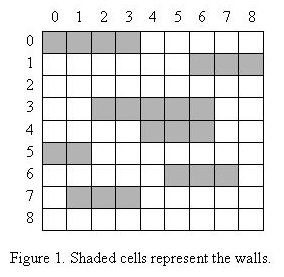POJ 1230 Pass-Muraille
来源:互联网 发布:长途打车软件 编辑:程序博客网 时间:2024/06/15 05:43
POJ 1230
Pass-Muraille
Time Limit: 1000MS Memory Limit: 65536KTotal Submissions: 9454 Accepted: 2934
Description
In modern day magic shows, passing through walls is very popular in which a magician performer passes through several walls in a predesigned stage show. The wall-passer (Pass-Muraille) has a limited wall-passing energy to pass through at most k walls in each wall-passing show. The walls are placed on a grid-like area. An example is shown in Figure 1, where the land is viewed from above. All the walls have unit widths, but different lengths. You may assume that no grid cell belongs to two or more walls. A spectator chooses a column of the grid. Our wall-passer starts from the upper side of the grid and walks along the entire column, passing through every wall in his way to get to the lower side of the grid. If he faces more than k walls when he tries to walk along a column, he would fail presenting a good show. For example, in the wall configuration shown in Figure 1, a wall-passer with k = 3 can pass from the upper side to the lower side choosing any column except column 6.

Given a wall-passer with a given energy and a show stage, we want to remove the minimum number of walls from the stage so that our performer can pass through all the walls at any column chosen by spectators.

Given a wall-passer with a given energy and a show stage, we want to remove the minimum number of walls from the stage so that our performer can pass through all the walls at any column chosen by spectators.
Input
The first line of the input file contains a single integer t (1 <= t <= 10), the number of test cases, followed by the input data for each test case. The first line of each test case contains two integers n (1 <= n <= 100), the number of walls, and k (0 <= k <= 100), the maximum number of walls that the wall-passer can pass through, respectively. After the first line, there are n lines each containing two (x, y) pairs representing coordinates of the two endpoints of a wall. Coordinates are non-negative integers less than or equal to 100. The upper-left of the grid is assumed to have coordinates (0, 0). The second sample test case below corresponds to the land given in Figure 1.
Output
There should be one line per test case containing an integer number which is the minimum number of walls to be removed such that the wall-passer can pass through walls starting from any column on the upper side.
Sample Input
23 12 0 4 00 1 1 11 2 2 27 30 0 3 06 1 8 12 3 6 34 4 6 40 5 1 55 6 7 61 7 3 7
Sample Output
11
Hint
Walls are parallel to X.
Source
Tehran 2002 Preliminary
题意:
魔术师前方有 n 堵墙,而他每次最多能跳过 k 堵墙,求拆掉最少的墙,使他在任意列都能一次跳过所有的墙。
贪心,从左向右遍历当前列的墙的个数,假设当前列的墙数超过了 k 堵,拆,开始想的把在当前列的长度最大的墙拆了
后来想想,当前列前面的墙无论多长都没有什么影响,所以,
每次选择所在当前列的墙中右端点最大的删除,这样才能对后面的影响最小,
使后面拆的墙数最少,为最优方案。
代码:
#include <cstdio>#include <cstring>#include <iostream>#include <algorithm>using namespace std;struct wall{ int x1, y1, x2, y2, ok; //ok记录墙是否拆了,1表示未拆,0表示拆了} W[110];int main(){ int t, n, k; scanf("%d", &t); while(t--) { scanf("%d%d", &n, &k); int mx = 0; //记录所有墙的最右端点 for(int i = 0; i < n; i++) { scanf("%d%d%d%d", &W[i].x1, &W[i].y1, &W[i].x2, &W[i].y2); if(W[i].x1 > W[i].x2) swap(W[i].x1, W[i].x2); //刚开始没写,坑我WA一次 W[i].ok = 1; //标记所有的墙都未拆 mx = max(mx, W[i].x2); } int sum = 0; for(int i = 0; i <= mx; i++) //判断点 i 所在列有几堵墙 { int cnt = 0; for(int j = 0; j < n; j++) if(i >= W[j].x1 && i <= W[j].x2 && W[j].ok == 1) cnt++; if(cnt <= k) continue; //墙数不超过k,继续判断下一列 cnt -= k; //删除 cnt 个墙 sum += cnt; while(cnt--) { int End = 0, id = 0; //贪心,这里删除满足条件的右端点最大的墙 for(int k = 0; k < n; k++) if(W[k].ok == 1 && i >= W[k].x1 && i <= W[k].x2 && W[k].x2 > End) { id = k; End = W[k].x2; } W[id].ok = 0; } } printf("%d\n", sum); } return 0;} 0 0
- POJ 1230 Pass-Muraille
- poj 1230 Pass-Muraille
- poj 1230 Pass-Muraille
- POJ-1230-Pass-Muraille
- poj 1230 Pass-Muraille
- POJ 1230 Pass-Muraille
- POJ-1230 Pass-Muraille
- POJ 1230 Pass-Muraille
- poj 1230 Pass-Muraille( 贪心 )
- poj 1230 Pass-Muraille 贪心
- POJ 1230 Pass-Muraille 贪心
- POJ 1230 Pass-Muraille 贪心
- POJ 1230 Pass-Muraille 笔记
- (贪心5.1.1)POJ 1230 Pass-Muraille
- POJ 1230 Pass-Muraille (贪心) 解题报告
- POJ 1230 Pass-Muraille (贪心)
- POJ 1230 Pass-Muraille (贪心)
- Pass-Muraille
- 用CasperJs自动浏览页面
- 关于face++出现1302 IMAGE_ERROR_FAILED_TO_DOWNLOAD错误的一点思路
- 让效率“爆表”的49个数据可视化工具
- cisco3550端口限速
- Docker背后的内核知识—Namespace资源隔离
- POJ 1230 Pass-Muraille
- 前端知识点大全
- 读书笔记MoreEffectiveC++(7)
- CF 558C Amr and Chemistry
- Activity 之间 传递 List 封装的对象或者对象
- 面试题7:用两个栈实现队列和用两个队列实现栈
- Nexus5(LG手机)刷机教程
- Ogre按键消息
- Spring IOC核心源码学习


